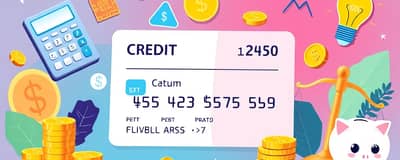Credit Card Statements Simplified: 6 Tips for Easy Understanding

Credit cards can be a useful financial tool, but understanding your credit card statement is essential for managing your finances effectively. Many people overlook the details on their statements, leading to confusion and potential financial pitfalls. By simplifying the process of reviewing your statement, you can gain better control over your spending, avoid unnecessary fees, and make informed financial decisions.
In this blog post, we will break down key tips to help you navigate your credit card statements with ease. Whether you’re a seasoned credit card user or new to the world of plastic money, understanding these essential components will empower you to handle your finances more confidently.
1. Break Down the Basics

Before diving into the specifics of your credit card statement, it's important to familiarize yourself with its basic layout. Most statements follow a standard structure that includes crucial information such as your balance, payment due date, and interest rate. Understanding these elements is the first step towards mastering your statement.
Begin by locating your current balance at the top of the statement. This number represents the total amount you owe at the time the statement was issued. Equally important is the minimum payment due, which indicates the smallest amount you must pay to avoid any penalty fees. Finally, your interest rate, often provided as an Annual Percentage Rate (APR), details how much interest you will incur if you carry a balance.
Knowing these basics will provide you with a foundational understanding of your statement and set the stage for a more in-depth analysis as we explore the other sections. It’s also helpful to be aware of the statement’s billing cycle, which dictates when purchases are recorded and when payment is due.
- Current Balance
- Payment Due Date
- Minimum Payment
- Interest Rate
- Billing Cycle
Having identified the basic components of your credit card statement, it is essential to keep these details in mind as you move forward. Each aspect serves as a building block for more advanced financial literacy and savvy credit management.
With the basics understood, let's delve into the key sections of your statement that demand your attention each month.
2. Focus on the Key Sections

Once you're familiar with the basic components of your credit card statement, it’s critical to zero in on the key sections that provide insight into your spending habits and payment requirements. Look for sections related to transactions, payment history, and rewards earned, as these will give you a comprehensive view of your credit card usage.
The transaction section lists all purchases made during the billing cycle, often categorized by type, such as groceries, travel, or entertainment. Understanding where your money goes can help you identify spending patterns and potential areas to cut back. Also, review your payment history to ensure that all payments have been applied accurately. This can prevent any discrepancies that might affect your credit score.
- Transaction History
- Payment History
- Rewards Points
- Credit Limit
- Fees and Charges
By focusing on these integral sections, you are better equipped to take control of your financial habits and make adjustments as necessary. Continual assessment of your transactions and payments can help cultivate responsible credit usage and encourage smart spending decisions.
Now that we have covered the need to focus on the sections that matter, let’s turn our attention to a critical aspect: dates.
3. Mind the Dates

Dates on your credit card statement are not just numbers; they carry significant implications for your financial well-being. Pay attention to the statement closing date, which marks the end of the billing cycle and is the cutoff for transactions that will be included in the current statement. Understanding this date helps you strategize your payments and manage your credit use effectively.
Also, take note of the payment due date. This is when your payment must be received by your credit card issuer to avoid late fees and potential interest hikes. Failing to pay on time can negatively impact your credit score and lead to additional financial stress.
- Statement Closing Date
- Payment Due Date
- Transaction Dates
- Payment Posted Date
Staying aware of these essential dates will help you keep your finances on track and avoid surprises in your statement. As we progress further, let's demystify some of the common terminology found on your statement.
4. Understand the Lingo

The financial jargon in credit card statements can often feel overwhelming. Terms like APR, grace period, and minimum payment can leave users confused and unsure of their meanings. It’s crucial to understand the terminology to interpret your statement correctly and navigate the world of credit with ease.
Begin by familiarizing yourself with basic terms. Knowing what APR (Annual Percentage Rate) means can help you comprehend how much interest you will accrue on any unpaid balance; a lower APR indicates a more favorable interest rate. Likewise, the grace period refers to the time frame in which you can pay your balance without incurring interest.
- Annual Percentage Rate (APR)
- Grace Period
- Cash Advance Fee
- Foreign Transaction Fee
- Credit Limit
Grasping these common terms will make interacting with your credit card statement far less intimidating. An informed credit card holder is a more powerful one, allowing for smarter utilization of credit. Next, let’s explore how to analyze your spending categories effectively.
5. Analyze Spending Categories

Understanding your spending categories can be a game changer when it comes to credit card usage. By categorizing your expenses, you can quickly see where the majority of your money is going and make informed adjustments to your budget. Take the time to review your transactions and group them accordingly, whether it’s food, travel, or entertainment expenses.
Look for trends in your spending habits: Are you overspending in certain areas? Are there categories where you could cut back to save money? Evaluating these categories can aid in developing a healthier financial plan moving forward.
- Grocery Spend
- Dining Out
- Travel Expenses
- Entertainment Costs
- Utilities and Bills
Through thorough analysis of your spending categories, you can uncover insights that will lead to better financial decisions and enhanced control over your credit card usage.
As we wrap up our tips, let’s not forget about another significant aspect of credit card management: fees and interest.
6. Watch for Fees and Interest

Fees and interest charges can add up quickly on credit card statements, making it crucial to understand how they work. Review your statement for any additional charges, including late fees, cash advance fees, or foreign transaction fees. These costs can easily derail your financial plan if left unchecked.
Heightened awareness of your card’s interest rates is equally important. If you carry a balance on your credit card, you can incur significant interest charges. Understanding how your issuer calculates interest can help you plan your payments and avoid unnecessary fees.
- Late Fees
- Cash Advance Fees
- Annual Fees
- Balance Transfer Fees
- Foreign Transaction Fees
By keeping an eye on fees and interest, you can avert unexpected charges that disrupt your financial goals and manage your credit card more effectively. Lastly, let’s conclude our guide with a few final thoughts.
Conclusion

Navigating a credit card statement doesn’t have to be daunting. With a little practice and familiarity, you can transform this task into a simple component of your financial management routine. By breaking down the basics, focusing on key sections, and understanding your spending habits, you’re well on your way to mastering your credit card use.
Implementing these tips will empower you to take control of your finances and make informed decisions moving forward. Remember, knowledge is your best tool in successfully managing your credit and avoiding pitfalls inherent to credit card usage.






